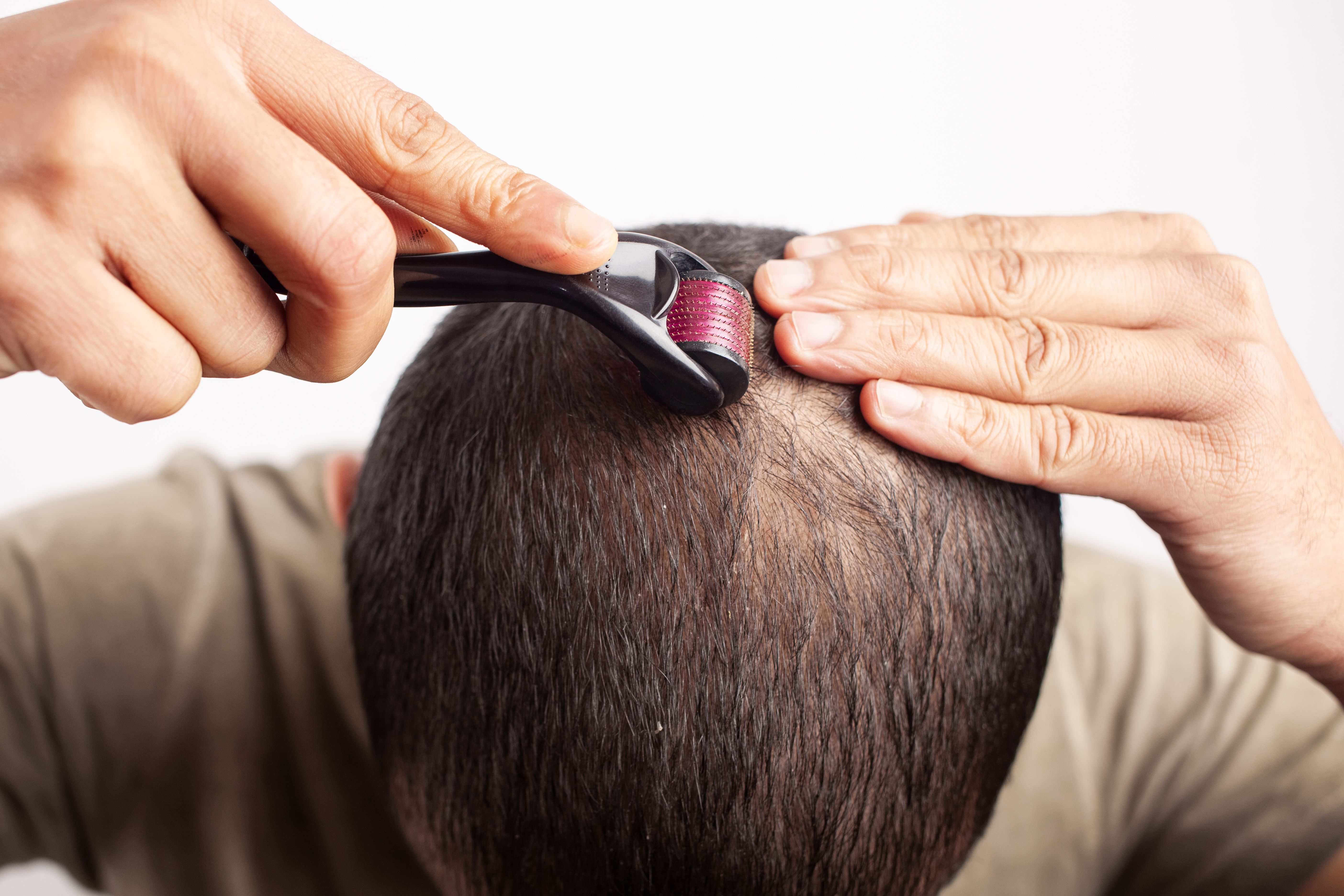News
Article
Scalp Repair Serum Microneedling: Fewer Treatments, More Hair Regrowth for AGA
Author(s):
A study found scalp repair serum microneedle combined therapy with medication to improve hair growth outcomes for patients with moderate to severe androgenetic alopecia (AGA) and reduce the number of microneedling sessions necessary.
Microneedling hair loss treatment | Image Credit: Dharma - stock.adobe.com

Scalp repair serum microneedling combined with oral therapy for moderate to severe androgenetic alopecia (AGA) enhanced treatment efficacy, improved therapeutic outcomes, and reduced the number of scalp microneedling treatments required in a study published in Skin Research and Technology.1
Androgenetic alopecia is the most prevalent form of hair loss disease and typically manifests as reduced hair density on both sides of the forehead, gradually thinning hair extending to the crown of the head, receding hairlines, and an M-shaped frontal hairline. Also known as male pattern baldness, AGA affects about two-thirds of all people assigned male at birth, and the odds increase with age.2 A quarter of the population assigned male at birth witness the first signs of hair loss by age 21. At age 50, half of this population faces hair loss, increasing to 70% if older than 50 years.
Treatment options include oral administration of finasteride, ethinylestradiol, cyproterone, and spironolactone; topical application of minoxidil, phototherapy, and microneedling; hair transplantations; and various others. Microneedling is often appealing to patients because it is known to be a minimally invasive treatment that can enhance transdermal absorption of drugs, induce collagen production, angiogenesis, and production of various growth factors in treated areas.
Microneedling, often conducted with a roller with tiny needles on it, works to induce stem cells in hair follicles that can lead to hair growth. Needle size ranges from less than 1 millimeter in length to a few millimeters long.3
The present study included data from a hair medicine research center alopecia specialty clinic collected from August 2022 to December 2022.1 The purpose of the study was to evaluate the efficacy and safety of scalp repair serum microneedles in combination with oral therapy for moderate to severe AGA.
A total of 20 patients (4 males, 16 females) between 28 and 46 years old with an average age of 36.95 years were enrolled in the study. Of the 20 patients, 15 were considered moderate alopecia while 5 were defined as severe alopecia.
Men were administered a 1 mg oral tablet of finasteride once a day, topical application of 5% minoxidil (5% concentration, 1 mL each time), and biweekly scalp repair serum microneedle therapy. Women were administered a 20 mg oral tablet 3 times a day of either spironolactone or ethinylestradiol cyproterone, 2% minoxidil (1 mL), paired with biweekly scalp repair serum microneedle therapy sessions.
Every participant underwent 7 rounds of biweekly microneedling treatment for 3 months total, with a follow-up conducted 1 month after treatment initially ended. Efficacy and adverse reactions were analyzed every 2 weeks, with the number of hairs recorded as N at the 7 treatment time points and at follow-up (i.e., N1-N8) and the improvement amount of each treatment was recorded as T, with T1-T6 including microneedling and T7 representing the improvement after stopping the scalp repair serum microneedling and only maintaining oral and topical treatments.
On average, results showed an increase of 42.6 hairs and an efficacy rate of 100%. There were statistically noticeable differences among the number of hairs between groups (P < .001, partial Eta squared = .872). From N1 to N7, significant differences in number of hairs between any 2 treatments were detected (P < .001). After a Bonferroni correction was applied for pairwise comparison, it revealed no significant difference between N7 and N8 (P > .05).
There were significant improvements observed with each microneedling treatment (P < .001). Significant differences between the S-N-K post hoc test results revealed disparities between T7 and T1 through T6 (P < .05).
There were prevalent negative correlations between the pretreatment hair count at N1 and total improvement (P < .001). Ultimately, the worse the baseline situation was, the better potential for total improvement.
None of the patients experienced adverse reactions or allergies from treatment. Microneedling treatment reportedly caused some pain and desquamation, constituting most discomfort symptoms acknowledged. However, the pain subsided on its own only a few hours following treatment and none of the patients discontinued treatment due to intolerable pain.
In an interview with The American Journal of Managed Care®, Monica Li, MD, medical and cosmetic dermatologist, and clinical assistant professor at the University of British Columbia stated, “We have to educate our patients to avoid applying any actives, especially immediately after the treatment, but also within the first several days, until the post procedure redness and puffiness resolves. This is important so that we don’t further irritate the skin.”4 This suggestion is vital to patients who may benefit from scalp repair serum microneedling combination treatment but risk benefits if not they’re not properly completing aftercare.
Study limitations were mainly related to the small sample size of participants.1 Scalp repair serum microneedling combined with minoxidil to treat moderate to severe AGA allows for a simple operation, avoids infections or other risks in preparation of blood, reduces costs and economic burdens, while avoiding adverse effects like pain or allergies as patient compliance improves.
References
1. Zhang F, Jia S, Ye B, et al. Observing the clinical efficacy of combined serum microneedle therapy for moderate to severe androgenetic alopecia in scalp repair. Skin Res Technol. 2024;30(2). doi:10.1111/srt.13612
2. Male pattern baldness (androgenic alopecia): stages, treatment. Cleveland Clinic. December 9, 2022. Accessed May 10, 2024. https://my.clevelandclinic.org/health/diseases/24515-male-pattern-baldness-androgenic-alopecia
3. Cherney K, Kramer O. Can scalp microneedling regrow your hair? Healthline. August 7, 2018. Accessed May 10, 2024. https://www.healthline.com/health/microneedling-for-hair-loss#cost
4. Steinzor P, McCormick B. Dr Monica Li lists microneedling considerations, precautions. AJMC. April 2, 2024. Accessed May 10, 2024. https://www.ajmc.com/view/dr-monica-li-lists-microneedling-considerations-precautions





